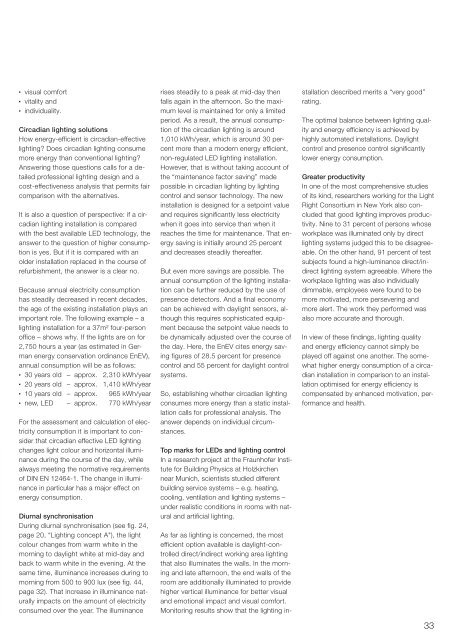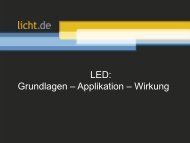licht.wissen 19 No. "Impact of Light on Human Beings"
Light synchronises our “internal clock”. Lighting that copies daylight has more than just a visual impact; it supports bodily functions 24 hours a day. Booklet 19 is intended for all those who want to delve into the topic of Impact of Light on Human Beings. The 56 pages helps to get an overview of what melanopic light can effect. Free Download at www.licht.de/en
Light synchronises our “internal clock”. Lighting that copies daylight has more than just a visual impact; it supports bodily functions 24 hours a day. Booklet 19 is intended for all those who want to delve into the topic of Impact of Light on Human Beings. The 56 pages helps to get an overview of what melanopic light can effect. Free Download at www.licht.de/en
Create successful ePaper yourself
Turn your PDF publications into a flip-book with our unique Google optimized e-Paper software.
visual comfort<br />
vitality and<br />
individuality.<br />
Circadian lighting soluti<strong>on</strong>s<br />
How energy-efficient is circadian-effective<br />
lighting? Does circadian lighting c<strong>on</strong>sume<br />
more energy than c<strong>on</strong>venti<strong>on</strong>al lighting?<br />
Answering those questi<strong>on</strong>s calls for a detailed<br />
pr<str<strong>on</strong>g>of</str<strong>on</strong>g>essi<strong>on</strong>al lighting design and a<br />
cost-effectiveness analysis that permits fair<br />
comparis<strong>on</strong> with the alternatives.<br />
It is also a questi<strong>on</strong> <str<strong>on</strong>g>of</str<strong>on</strong>g> perspective: if a circadian<br />
lighting installati<strong>on</strong> is compared<br />
with the best available LED technology, the<br />
answer to the questi<strong>on</strong> <str<strong>on</strong>g>of</str<strong>on</strong>g> higher c<strong>on</strong>sumpti<strong>on</strong><br />
is yes. But if it is compared with an<br />
older installati<strong>on</strong> replaced in the course <str<strong>on</strong>g>of</str<strong>on</strong>g><br />
refurbishment, the answer is a clear no.<br />
Because annual electricity c<strong>on</strong>sumpti<strong>on</strong><br />
has steadily decreased in recent decades,<br />
the age <str<strong>on</strong>g>of</str<strong>on</strong>g> the existing installati<strong>on</strong> plays an<br />
important role. The following example – a<br />
lighting installati<strong>on</strong> for a 37m² four-pers<strong>on</strong><br />
<str<strong>on</strong>g>of</str<strong>on</strong>g>fice – shows why. If the lights are <strong>on</strong> for<br />
2,750 hours a year (as estimated in German<br />
energy c<strong>on</strong>servati<strong>on</strong> ordinance EnEV),<br />
annual c<strong>on</strong>sumpti<strong>on</strong> will be as follows:<br />
<br />
30 years old – approx. 2,310 kWh/year<br />
<br />
20 years old – approx. 1,410 kWh/year<br />
<br />
10 years old – approx. 965 kWh/year<br />
<br />
new, LED – approx. 770 kWh/year<br />
For the assessment and calculati<strong>on</strong> <str<strong>on</strong>g>of</str<strong>on</strong>g> electricity<br />
c<strong>on</strong>sumpti<strong>on</strong> it is important to c<strong>on</strong>sider<br />
that circadian effective LED lighting<br />
changes light colour and horiz<strong>on</strong>tal illuminance<br />
during the course <str<strong>on</strong>g>of</str<strong>on</strong>g> the day, while<br />
always meeting the normative requirements<br />
<str<strong>on</strong>g>of</str<strong>on</strong>g> DIN EN 12464-1. The change in illuminance<br />
in particular has a major effect <strong>on</strong><br />
energy c<strong>on</strong>sumpti<strong>on</strong>.<br />
Diurnal synchr<strong>on</strong>isati<strong>on</strong><br />
During diurnal synchr<strong>on</strong>isati<strong>on</strong> (see fig. 24,<br />
page 20, “<str<strong>on</strong>g>Light</str<strong>on</strong>g>ing c<strong>on</strong>cept A"), the light<br />
colour changes from warm white in the<br />
morning to daylight white at mid-day and<br />
back to warm white in the evening. At the<br />
same time, illuminance increases during to<br />
morning from 500 to 900 lux (see fig. 44,<br />
page 32). That increase in illuminance naturally<br />
impacts <strong>on</strong> the amount <str<strong>on</strong>g>of</str<strong>on</strong>g> electricity<br />
c<strong>on</strong>sumed over the year. The illuminance<br />
rises steadily to a peak at mid-day then<br />
falls again in the afterno<strong>on</strong>. So the maximum<br />
level is maintained for <strong>on</strong>ly a limited<br />
period. As a result, the annual c<strong>on</strong>sumpti<strong>on</strong><br />
<str<strong>on</strong>g>of</str<strong>on</strong>g> the circadian lighting is around<br />
1,010 kWh/year, which is around 30 percent<br />
more than a modern energy efficient,<br />
n<strong>on</strong>-regulated LED lighting installati<strong>on</strong>.<br />
However, that is without taking account <str<strong>on</strong>g>of</str<strong>on</strong>g><br />
the “maintenance factor saving” made<br />
possible in circadian lighting by lighting<br />
c<strong>on</strong>trol and sensor technology. The new<br />
installati<strong>on</strong> is designed for a setpoint value<br />
and requires significantly less electricity<br />
when it goes into service than when it<br />
reaches the time for maintenance. That energy<br />
saving is initially around 25 percent<br />
and decreases steadily thereafter.<br />
But even more savings are possible. The<br />
annual c<strong>on</strong>sumpti<strong>on</strong> <str<strong>on</strong>g>of</str<strong>on</strong>g> the lighting installati<strong>on</strong><br />
can be further reduced by the use <str<strong>on</strong>g>of</str<strong>on</strong>g><br />
presence detectors. And a final ec<strong>on</strong>omy<br />
can be achieved with daylight sensors, although<br />
this requires sophisticated equipment<br />
because the setpoint value needs to<br />
be dynamically adjusted over the course <str<strong>on</strong>g>of</str<strong>on</strong>g><br />
the day. Here, the EnEV cites energy saving<br />
figures <str<strong>on</strong>g>of</str<strong>on</strong>g> 28.5 percent for presence<br />
c<strong>on</strong>trol and 55 percent for daylight c<strong>on</strong>trol<br />
systems.<br />
So, establishing whether circadian lighting<br />
c<strong>on</strong>sumes more energy than a static installati<strong>on</strong><br />
calls for pr<str<strong>on</strong>g>of</str<strong>on</strong>g>essi<strong>on</strong>al analysis. The<br />
answer depends <strong>on</strong> individual circumstances.<br />
Top marks for LEDs and lighting c<strong>on</strong>trol<br />
In a research project at the Fraunh<str<strong>on</strong>g>of</str<strong>on</strong>g>er Institute<br />
for Building Physics at Holzkirchen<br />
near Munich, scientists studied different<br />
building service systems – e.g. heating,<br />
cooling, ventilati<strong>on</strong> and lighting systems –<br />
under realistic c<strong>on</strong>diti<strong>on</strong>s in rooms with natural<br />
and artificial lighting.<br />
As far as lighting is c<strong>on</strong>cerned, the most<br />
efficient opti<strong>on</strong> available is daylight-c<strong>on</strong>trolled<br />
direct/indirect working area lighting<br />
that also illuminates the walls. In the morning<br />
and late afterno<strong>on</strong>, the end walls <str<strong>on</strong>g>of</str<strong>on</strong>g> the<br />
room are additi<strong>on</strong>ally illuminated to provide<br />
higher vertical illuminance for better visual<br />
and emoti<strong>on</strong>al impact and visual comfort.<br />
M<strong>on</strong>itoring results show that the lighting installati<strong>on</strong><br />
described merits a “very good”<br />
rating.<br />
The optimal balance between lighting quality<br />
and energy efficiency is achieved by<br />
highly automated installati<strong>on</strong>s. Daylight<br />
c<strong>on</strong>trol and presence c<strong>on</strong>trol significantly<br />
lower energy c<strong>on</strong>sumpti<strong>on</strong>.<br />
Greater productivity<br />
In <strong>on</strong>e <str<strong>on</strong>g>of</str<strong>on</strong>g> the most comprehensive studies<br />
<str<strong>on</strong>g>of</str<strong>on</strong>g> its kind, researchers working for the <str<strong>on</strong>g>Light</str<strong>on</strong>g><br />
Right C<strong>on</strong>sortium in New York also c<strong>on</strong>cluded<br />
that good lighting improves productivity.<br />
Nine to 31 percent <str<strong>on</strong>g>of</str<strong>on</strong>g> pers<strong>on</strong>s whose<br />
workplace was illuminated <strong>on</strong>ly by direct<br />
lighting systems judged this to be disagreeable.<br />
On the other hand, 91 percent <str<strong>on</strong>g>of</str<strong>on</strong>g> test<br />
subjects found a high-luminance direct/indirect<br />
lighting system agreeable. Where the<br />
workplace lighting was also individually<br />
dimmable, employees were found to be<br />
more motivated, more persevering and<br />
more alert. The work they performed was<br />
also more accurate and thorough.<br />
In view <str<strong>on</strong>g>of</str<strong>on</strong>g> these findings, lighting quality<br />
and energy efficiency cannot simply be<br />
played <str<strong>on</strong>g>of</str<strong>on</strong>g>f against <strong>on</strong>e another. The somewhat<br />
higher energy c<strong>on</strong>sumpti<strong>on</strong> <str<strong>on</strong>g>of</str<strong>on</strong>g> a circadian<br />
installati<strong>on</strong> in comparis<strong>on</strong> to an installati<strong>on</strong><br />
optimised for energy efficiency is<br />
compensated by enhanced motivati<strong>on</strong>, performance<br />
and health.<br />
33

















